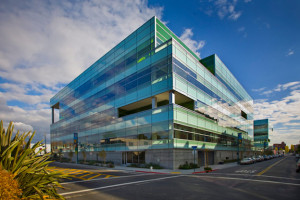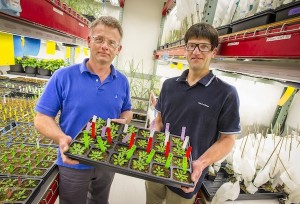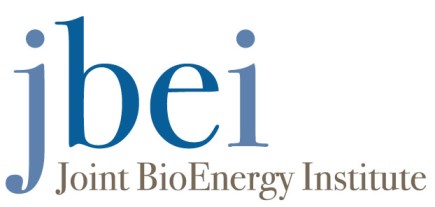
Headquartered in Emeryville, CA, the Joint BioEnergy Institute (JBEI) is now a member of the elite “100/500 Club,” having filed its 100th patent application and published its 500th scientific paper. (Photo by Roy Kaltschmidt)
The U.S. Department of Energy (DOE)’s Joint BioEnergy Institute (JBEI) is now a member of the elite “100/500 Club,” having filed its 100th patent application and published its 500th scientific paper. Established in 2007 as one of three DOE Bioenergy Research Centers (BRCs) with the ultimate goal of accelerating the development of advanced, next-generation biofuels, JBEI is a multi-institutional partnership led by Lawrence Berkeley National Laboratory (Berkeley Lab).
“Achieving the 100/500 milestones helps convey the impact of JBEI research on both the scientific and industrial communities,” says Blake Simmons, JBEI’s Chief Science and Technology Officer and Vice President of the Deconstruction Division. “While we take great pride in reaching these metrics, they are only a part of the true impact of JBEI, as we have several startup companies and over 60 licenses executed that stem from our scientific results and related intellectual property.”
Simmons is one of the authors of the 500th JBEI publication, a paper appearing in the ISME journal titled, “Refining the phylum Chlorobi by resolving the phylogeny and metabolic potential of the representative of a deeply branching, uncultivated lineage.” The paper describes a study of a green sulfur bacteria that has the ability to efficiently break down lignocellulosic biomass for the production of advanced biofuels.
The 100th patent filed by JBEI is titled “Host Cells and Methods for Producing Diacid Compounds.” This work, which was led by JBEI CEO Jay Keasling, describes a technique for engineering host cells to produce one or more fatty acid-derived dicarboxylic acids or “diacids” the cells would not naturally produce.
“Dicarboxylic acids are used in everything from plastics and fabrics to perfume,” says Robert Haushalter, a member of the team that developed this technique. “Today these acids are most commonly derived from petro-chemical sources, but our technology allows us to produce them in engineered microbes directly from renewable sources like sugars.”

JBEI has licensed more than 60 technologies including the artificial positive feedback loop (APFL) developed by Henrik Scheller (left) and Dominique Loque shown here with a tray of Arabidopsis Thaliana plants. (Photo by Roy Kaltschmidt)
Advanced biofuels made from the lignocellulosic biomass of grasses, other non-food crops and agricultural waste have the potential to replace fossil fuels that are responsible for the annual release of nearly 9 billion metric tons of excess carbon into the atmosphere. The technologies that can be used to transform lignocellulosic biomass into fuels, especially techniques in synthetic biology, can also be applied to the sustainable production of medicines, polymers and other chemical products that today are being made from unsustainable resources, such as fossil fuels. This sustainability has been the driving factor behind DOE’s investment in its BRCs.
When JBEI was officially dedicated on December 2, 2008 at its state-of-the-art laboratory facility in Emeryville, California, it stood apart from the other BRCs in that it was organized along the lines of a biotech start-up company and was the only BRC housing most of its researchers in one facility.
“JBEI was established with an entrepreneurial and collaborative spirit as part of our institutional DNA,” Simmons says. “This outlook directly influences our approach to solving the most significant challenges that stand in the way of realizing affordable and sustainable advanced biofuels in the marketplace.”
That JBEI’s entrepreneurial spirit has enabled it to serve as a crucible for transformational discoveries is reflected not only in its prodigious 100/500 output, but also in the 63 and counting technologies that have been licensed or optioned to companies, along with 207 and counting invention disclosures.

Ai Oikawa, managing director of AFINGEN, the startup that licensed JBEI’s APFL technology. (Photo by Roy Kaltschmidt)
Companies that have licensed JBEI technologies include Lygos, which is using synthetic biology techniques to produce new chemical compounds, TeselaGen, which is building a bioCAD/CAM rapid prototyping system for biology, and, most recently, AFINGEN, which is using a new discovery from JBEI called “artificial positive feedback loop,” or APFL, to manipulate the metabolic pathways of plants for the production of advanced biofuels and other chemical products now being made from petroleum.
“AFINGEN’s goal is to improve beneficial bioenergy traits in eukaryotic organisms and APFL will help us achieve this goal,” says Ai Oikawa, AFINGEN’s Managing Director. “JBEI’s fundamental scientific discoveries, such as APFL, are a critical conduit for technology transfer.”
Two years ago, DOE renewed JBEI’s funding at the rate of $25 million annually through 2018. Then Secretary of Energy Steven Chu charged JBEI and the other BRCs with deploying innovative approaches and technologies to “move the biofuels industry forward and grow our economy while reducing our reliance on foreign oil.”
Through its uniquely nimble and flexible approach to research and its hallmark entrepreneurial and collaborative spirit, JBEI has been meeting and will continue to meet that charge, promises CEO Keasling.
“Even though our metrics are excellent, they still don’t do justice to the impact JBEI has had and will continue to have both in basic science as well as the application of that science,” Keasling says. “We’re here to solve one of the most important problems of our time, reducing the impact of transportation on the environment.”
Additional Information
For more about the Joint BioEnergy Institute go here
